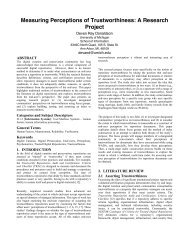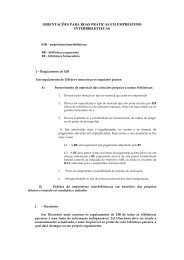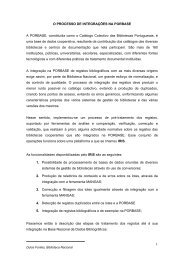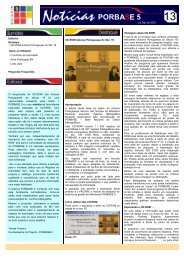Status report on global Neem usage - Biblioteca Nacional de Portugal
Status report on global Neem usage - Biblioteca Nacional de Portugal
Status report on global Neem usage - Biblioteca Nacional de Portugal
Create successful ePaper yourself
Turn your PDF publications into a flip-book with our unique Google optimized e-Paper software.
1. INTRODUCTION<br />
1. Introducti<strong>on</strong><br />
"The neem tree, the tree of the future" - this is more or less how all articles start when the<br />
Indian press features its neem tree. There is no doubt that the role this excepti<strong>on</strong>al tree with<br />
its manifold uses could play in securing food supply and protecting our envir<strong>on</strong>ment should<br />
not be un<strong>de</strong>restimated. The tree holds great potential for the reafforestati<strong>on</strong> of ero<strong>de</strong>d soils,<br />
for use as a natural pestici<strong>de</strong> and in medicine - to name just a few of the most important<br />
areas.<br />
The Deutsche Gesellschaft für Technische Zusammenarbeit (GTZ) GmbH started propagating<br />
the neem tree in <strong>de</strong>velopment-cooperati<strong>on</strong> projects in the 70ies. Initially, the GTZ focused<br />
<strong>on</strong> researching its active principles and various possible uses, but later channelled its efforts<br />
into disseminating the tree and knowledge of its practical uses, adressing first small farmers<br />
and ngo and later small scale entrepreneurs (7,8,16-19, 40). Today, the GTZ is working<br />
towards making this experience and knowledge available to broad secti<strong>on</strong>s of the populati<strong>on</strong>.<br />
To do so, work at project level al<strong>on</strong>e is not sufficient. Instead, neem <strong>usage</strong> has to be<br />
anchored <strong>on</strong> a broad basis in the populati<strong>on</strong> itself, a task requiring not <strong>on</strong>ly the commitment<br />
of state-run programmes, which propagate the neem tree and its various uses, but <strong>on</strong>e which<br />
also relies <strong>on</strong> private organisati<strong>on</strong>s and the private sector. For <strong>on</strong>ly when a varied group of<br />
sp<strong>on</strong>sors has come together will it be possible to integrate the neem tree sustainably and<br />
appropriately into the respective social setting.<br />
This study aims to document the current status of neem <strong>usage</strong> across the globe as well as<br />
the experience gained to date, with a view to generating a basis for future neem projects.<br />
The key focus is <strong>on</strong> neem's use as a n<strong>on</strong>-synthetic pestici<strong>de</strong>; probably neem's greatest<br />
potential besi<strong>de</strong> me<strong>de</strong>cin for use.<br />
In additi<strong>on</strong> to the informati<strong>on</strong> c<strong>on</strong>cerning neem's disseminati<strong>on</strong> and potential uses, this <str<strong>on</strong>g>report</str<strong>on</strong>g><br />
also presents the key projects, organisati<strong>on</strong>s and instituti<strong>on</strong>s that work with neem or have<br />
worked with it in the recent past. In so doing, the <str<strong>on</strong>g>report</str<strong>on</strong>g> looks into the various methods and<br />
technological approaches as well as the level of acceptance and the difficulties encountered<br />
in using neem. Various countries' activities with neem are given as examples.<br />
To gain as complete an overview as possible of the current status of neem <strong>usage</strong>, four<br />
different methods were used to obtain the requisite informati<strong>on</strong>:<br />
1. Evaluati<strong>on</strong> of the latest literature and publicati<strong>on</strong>s <strong>on</strong> the subject of neem.<br />
2. Disseminati<strong>on</strong> of a questi<strong>on</strong>naire c<strong>on</strong>cerning <strong>global</strong> neem <strong>usage</strong> to GTZ projects and<br />
other organisati<strong>on</strong>s, as well as instituti<strong>on</strong>s or private people who work with neem; subsequent<br />
evaluati<strong>on</strong>.<br />
3. Compilati<strong>on</strong> and evaluati<strong>on</strong> of documents pertaining to projects that have just been<br />
completed, as well as evaluati<strong>on</strong> of documentati<strong>on</strong> <strong>on</strong> existing projects which did not<br />
return the questi<strong>on</strong>naire.<br />
4. Review of our backstopping and project planning activities during the past 5 years.<br />
Technical data <strong>on</strong> the questi<strong>on</strong>naire: 111 questi<strong>on</strong>naires were sent out in 1996 worldwi<strong>de</strong>, 41<br />
to <strong>on</strong>going GTZ projects, 30 to GOs (instituti<strong>on</strong>s and projects), 34 to NGOs and 6 to private<br />
individuals. The resp<strong>on</strong>se rate totalled 42 %.<br />
6














